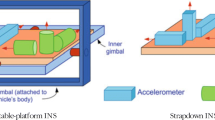Summary
Thresholds for the detection of linear oscillatory motion at 0.3 Hz in the X, Y and Z body axes were determined during the flight of Spacelab-1 and on the ground pre- and post-flight, using the method of limits with a single staircase procedure. Pre-flight, Z axis thresholds (mean 0.077 ms−2) were significantly higher than X and Y thresholds (mean 0.029 ms−2). Measures obtained on three crew members in-flight exhibited thresholds greater, by a factor of 1.5–4.3, than those obtained pre-flight. Post-flight, two crew members had significantly elevated X and Y axis thresholds whereas the other two crew members had lowered thresholds in X, Y and Z axes. In general, thresholds had returned to pre-flight levels by the second post-flight day. A possible explanation for these somewhat disparate responses is presented.
Similar content being viewed by others
References
Baumgarten RJ von, Vogel H (1976) Definition des Anteils des Statolithenorgans bei der Entwicklung der Raumkrankheit und die Anwendung bei Auswahl und Training von Nutzlastexperten. Publ. No. 01 QV 046-AA22-SLN 7751-A2a Köln/Porz: DFVLR
Baumgarten RJ von, Vogel H, Kass JR (1981) Nauseogenic properties of various dynamic and static force environments. Acta Astronautica 8: 1005–1013
Benson AJ (1977) Possible mechanisms of motioon and space sickness. In: Life-sciences research in space. Report SP-130, Paris: ESA pp 101–108
Benson AJ, Spencer MB, Stott JRR (1986) Thresholds for the detection of the direction of a whole-body linear movement in the horizontal plane. Aviat Space Environ Med (in press)
Benson A, von Baumgarten R, Bethoz A, Brandt Th, Brand U, Bruzek W, Dichgans J, Kass J, Probst Th, Scherer H, Vieville T, Vogel H, Weitzig J (1984) Some results of the European vestibular experiments in the Spacelab-1 mission. In: Results of space experiments in physiology and medicine. CP-377, 1B, 1–10, Neuilly-sur-Seine: AGARD/NATO
Benson AJ, Dilnot S (1981) Perception of whole-body linear oscillation. In: Irving A (ed) Proceedings UK human response to vibration meeting 1981. Heriot-Watt University, Edinburgh, pp 92–102
Engen T (1972) Psychophysics 1. Discrimination and detection. In: Kling JW, Riggs LA (eds) Woodworth and Schlosberg's experimental psychology, Chap 2. Methuen, London, pp 14–20
Fernandez C, Goldberg JM (1976) Physiology of peripheral neurons innervating otolith organs of the squirrel monkey. 1. Response to the static tilts and long-duration centrifugal forces. J Neurophysiol 39: 970–984
Greven AJ, Oosterveld WJ, Rademakers WJAC (1974) Linear acceleration perception. Arch Otolaryngol 100: 453–459
Gundry AJ (1978) Thresholds of perception for periodic linear motion. Aviat Space Environ Med 49: 679–686
Homick JL (1979) Space motion sickness. Acta Astronautica 6: 1259–1272
Kass JR, Bruzek W, Probst Th, Thümler R, Vieville Th, Vogel H (1986) European vestibular experiments on the Spacelab-1 mission: 2. Experimental equipment and methods. Exp Brain Res 64: 247–254
Lindeman HH (1969) Studies on the morphology of the sensory regions of the vestibular apparatus. Ergebn Anat Entwicklungsgesch 42: 1–113
Meiry JL (1965) The vestibular system and human dynamic space orientation Report T-65–1. MIT Press, Cambridge, MA
Melvill Jones G (1974) Adative neurobiology of space flight. Poceedings Skylab Life Sciences Symposium Vol 2. Report TM X-58154 Houston: NASA, pp 847–860
Oman CM (1982) Space motion sickness and vestibular experiments in Spacelab. Soc Automotive Eng 12th Intersoc Conf on Environmental Systems Paper no. 820833
Oman CM, Lichtenberg BK, Money KE (1984) Space motion sickness monitoring experiments: Spacelab 1. In: Motion sickness: mechanisms, prediction, prevention and treatment, CP-372 35, 1–21 Neuilly-sur-Seine: AGARD/NATO
Parker DE, Gulledge WL, Tubbs RL, Littlefield VM (1978) A temporary threshold shift for self-motion detection following sustained oscillating linear acceleration. Percept and Psychophys 23: 461–467
Parker DE, Reschke MF, Arrott AP, Homick JL, Lichtenberg BK (1984) Thresholds for detection of linear oscillation following prolonged weightlessness. Discussion of Benson et al. (1984). In: Results of space experiments in physiology and medicine. CP-377, 1B, 11–14, Neuilly-sur-Seine: AGARD/NATO
Reason JT, Brand JJ(1975) Motion sickness. Academic Press, London
Reschke MF, Anderson DJ, Homick JL (1984) Vestibulospinal reflexes as a function of microgravity. Science 225: 212–214
Steinz JA (1980) The sled programme. ESA Bull No. 22: 59–66
Walsh EG (1961) Role of the vestibular apparatus in the perceptiion of motion on a parallel swing. J Physiol 155: 506–513
Walsh EG (1962) The perception of rhythmically repeated linear motion in the horizontal plane. Br J Psychol 53: 439–445
Walsh EG (1964) The perceptioon of rhythmically repeated linear motion in the vertical plane. Q J Exp Physiol 49: 58–65
Young LR, Oman CM, Watt DGD, Money KE, Lichtenberg BK (1984) Spatial orientation in weightlessness and readaptation to Earth's gravity. Science 225: 205–208
Author information
Authors and Affiliations
Rights and permissions
About this article
Cite this article
Benson, A.J., Kass, J.R. & Vogel, H. European vestibular experiments on the Spacelab-1 mission: 4. Thresholds of perception of whole-body linear oscillation. Exp Brain Res 64, 264–271 (1986). https://doi.org/10.1007/BF00237742
Received:
Accepted:
Issue Date:
DOI: https://doi.org/10.1007/BF00237742




